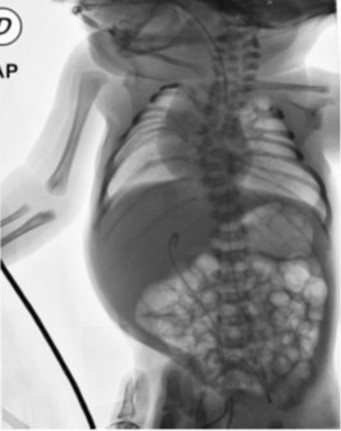Incidence estimated at 1/200,000, more frequent in the population of Puerto Rican origin.
Segmentation anomaly of the axial skeleton, resulting in a combination of vertebral and costal malformations.
From a genetic point of view, there are 6 autosomal recessive (consanguinity) causes (SCDO for SpondyloCostal DysOstosis):
- SCDO1 [MIM 277 300]: mutation of the DLL3 gene (7p22)
- SCDO2 [MIM 608 681]: mutation of the MESP2 gene (15q26.1), most common form in Puerto Rico
- SCDO3 [MIM 609 813]: mutation of the LFNG gene (7p22)
- SCDO4 [MIM 613 686]: mutation of the HES7 gene (17p13)
- SCDO5 [MIM 122 600] : mutation of the TBX6 gene (16p11); sometimes autosomal dominant transmission
- SCDO6 [MIM 616 566]: mutation of the RIPPLY2 gene (6q14)
Two phenotypes are distinguished:
1) spondylocostal dysplasia (considered by some to be the only presentation of Jarcho-Levin syndrome): vertebral and costal anomalies with a short neck; severe autosomal recessive or dominant transmission. Good prognosis.
2) spondylothoracic dysplasia (sometimes called Lavy-Moseley syndrome): crab-shaped thoracic deformity (image) without costal anomalies (normal but fused in their posterior part); sometimes associated with tracheal anomalies: absence of tracheal rings. High mortality in infancy due to reduced lung capacity (restrictive syndrome).

Presence of:
- a short stature with a short neck and trunk (upper limbs appear long)
- hemivertebrae mainly in the thoraco-lumbar region, more rarely in the cervical region; this leads to scoliosis
- rib anomalies: absence or posterior fusion of ribs, abnormalities of size and shape
More rarely :
- malformation of the odontoid process, absence of atlas
- spina bifida or tethered cord
- anal malformations (atresia, imperforation) (SCDO4), similar to Casamassima-Morton-Nance syndrome (see this term)
- cardiac malformations: ASD, abnormal pulmonary venous return or secondary pulmonary hypertension
- urogenital malformations: neurological bladder, hypospadias (SCDO4)
- Sprengel anomaly of the scapula (see this term)
- polydactyly (lower limb)
Anesthetic implications:
short stature, scoliosis, respiratory insufficiency, check cervical vertebrae, difficulties in performing a neuraxial block; short, narrow trachea; difficult intubation in case of stiff neck. Surgical approach to the abdomen can be complicated (short stature + scoliosis).
References :
- Vazquez-Lopez ME, Lopez-Conde MI, Somoza-Rubio C et al.
Anomalies vertébrales et costales : syndrome de Jarcho-Levin.
Description d’un cas et revue de la littérature.
Revue du Rhumatisme 2005 ; 72 : 448-81.
- Dolak JA, Tartt S.
Spinal anesthesia for cesarean delivery in a parturient with spondylocostal dysostosis.
Can J Anaesth. 2009;56:172-3.
- Sabaretnam S, Chin J, Kajekar P.
Anaesthetic considerations in a parturient with Jarcho-Levin Syndrome.
Int J Obstet Anesth. 2019;41:125–6.
- Zbeidy R, Buendia NT, Souki FG.
Anaesthetic management of a parturient with spondylothoracic dysostosis.
BMJ Case Rep. 2020;13.
- Ibrahim MA, Almetwalli RR.
Anesthetic management of a parturient with spondylocostal dysostosis (Jarcho-Levin syndrome) for cesarean delivery.
Anaesth Pain Intens Care. 2023;27:780-2
- Bellamy J, Pye S.
Anesthesia for cesarean delivery in a patient with spondylocostal dysostosis: a case report.
A &A Practice 2024;18:e01881.
Updated: January 2025